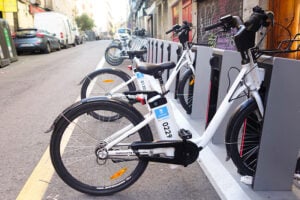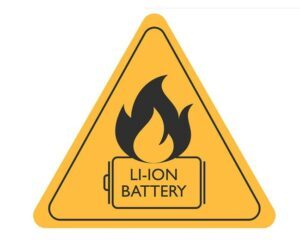Just 15% of organisations say they have conducted a workplace fire risk assessment to cover the risks posed by devices containing lithium-ion batteries (LiB), new research finds. Firechief Global urges organisations to get risk assessed for lithium-ion battery usage.
The data was gathered from over 500 organisations who were surveyed during webinars held by both IFSEC Insider and Firechief Global last autumn, and while 15% of respondents confirmed they had updated their fire risk assessments to cover the risk of LiB fires, 71% said they had not and a further 14% were unsure.
Click here to read answers to popular questions from SHP and IFSEC Insider’s joint webinar with Firechief’s Matt Humby: Lithium-Ion battery fire safety – Your questions answered
“It makes sense to address the fire risk”

Image credit: Perry van Munster/AlamyStock
Lithium-ion batteries are now firmly part of daily life, both at home and in the workplace.
They are to be found in portable devices, electric vehicles, and renewable energy storage systems. Lithium-ion batteries have many advantages, but their safety depends on how they are manufactured, how they are used and stored and how they are recycled.
“A typical workplace is likely to have many devices containing Lithium-ion batteries” said Laurie Pollard, Managing Director of Firechief Global. “There will be mobile phones, laptops, e-bikes, e-scooters, and electric vehicles being used, stored, and charged on site and that’s before considering other equipment such as forklift trucks, power tools, and energy storage systems etc, so it makes sense to assess the fire risk these could pose should the worst happen, and then have an action plan in place to mitigate those risks.
“Clearly organisations will have many types of different risks given that there’s a huge variety of different lithium battery applications and integrations. Some lithium-ion battery risks are mobile, some are built into portal machinery, others are static.
“Sometimes it might be the handling of lithium-ion batteries that’s a risk. The batteries may be damaged, they may not; they may be brand new; they may be low in charge, they may potentially be highly charged. So, a strategy must be developed and created for the specific risk that is present”.
Identifying the scale of the risk you have present could simply mean the number of lithium-ion batteries being stored. This will include any old laptops which have been returned by employees. Could these be recycled rather than stored perhaps? Where is the EV fleet being charged? Is it next to or near fire exits?
There is no regulation about charging electric vehicles at the moment so the charging points can be sited anywhere. Do you allow staff to bring e-Bikes or e-Scooters on to site? Are they allowed to charge them on site? It’s about identifying the scale of the risk present.
Different strategies needed for the cycle of battery usage
 Firechief recommends to always get a fire risk assessment conducted by a competent person to identify the scale of the risks present on your particular site.
Firechief recommends to always get a fire risk assessment conducted by a competent person to identify the scale of the risks present on your particular site.
There will be Lithium-ion batteries in use, LiB batteries being charged and being swapped out, and there will be damaged batteries to be handled, controlled, and contained, and then batteries to be disposed of. All of these will require a different strategy and a specific assessment as to what the best solution is for that particular need at that particular state in the battery lifecycle, so assess your site-specific risk and then create your strategy to deal with that risk.
To help mitigate the risk of Lithium-ion battery fires, Firechief has an eight-step battery safe action plan which includes proactive actions such as assessing the scale of risk that’s present in your environment and a range of reactive actions to deal with a lithium-ion battery thermal event, but the starting point is going right back to basics and re-assessing your particular risks at the earliest opportunity.
Firechief is also a supporter of the Battery safety Bill. Organised by the charity Electrical Safety First it aims to tackle the alarming rise in deadly e-bike and e-scooter fires across the UK and support is now being sought from MPs who are willing to back the Bill.
This article was first published on SHP’s sister site for fire and security news, IFSEC Insider.
Fire Safety in 2023 eBook
SHP's sister site, IFSEC Insider has released its annual Fire Safety Report for 2023, keeping you up to date with the biggest news and prosecution stories from around the industry.
Chapters include important updates such as the Fire Safety (England) Regulations 2022 and an overview of the new British Standard for the digital management of fire safety information.
Plus, explore the growing risks of lithium-ion battery fires and hear from experts in disability evacuation and social housing.


 Firechief recommends to always get a fire risk assessment conducted by a competent person to identify the scale of the risks present on your particular site.
Firechief recommends to always get a fire risk assessment conducted by a competent person to identify the scale of the risks present on your particular site.